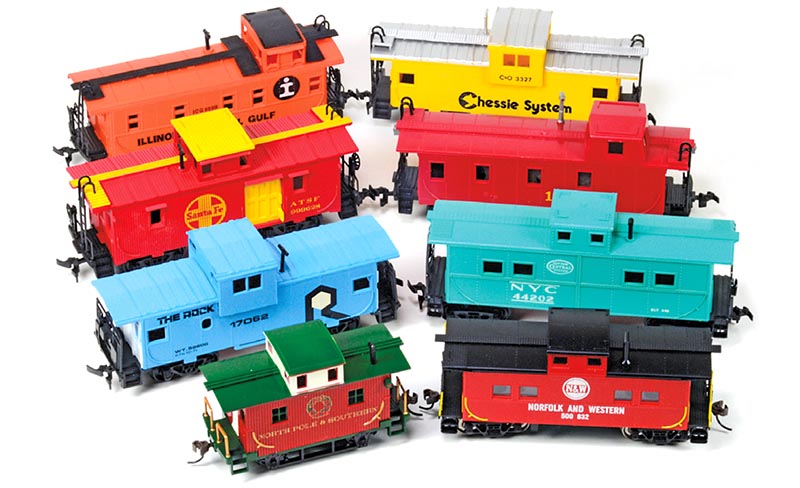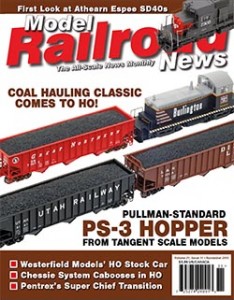In this issue, Tony Lucio presented a pair of HO-scale Chessie System caboose models. The Bachmann model is the company’s current version of its wide-vision example. Since its 1970 introduction, Bachmann has offered a number of HO caboose models. When I began this survey, my thought was Bachmann had cataloged perhaps three or four caboose models during its many years in the HO market. As you’ll discover with me, there are more examples than you might expect to find for Bachmann HO caboose models.
The first collection of Bachmann HO scale rolling stock presented a 36-foot off-center cupola steel caboose. The company’s first catalog with HO locomotives and rolling stock offered six road names: Chicago, Burlington & Quincy (CB&Q); Great Northern; Penn Central; Pennsylvania; Santa Fe; and Union Pacific. All early Bachmann train sets included this caboose, and additional road names came along throughout the 1970s. Additionally, collectors will find Canadian-exclusive road names for this and other Bachmann HO items from this period.
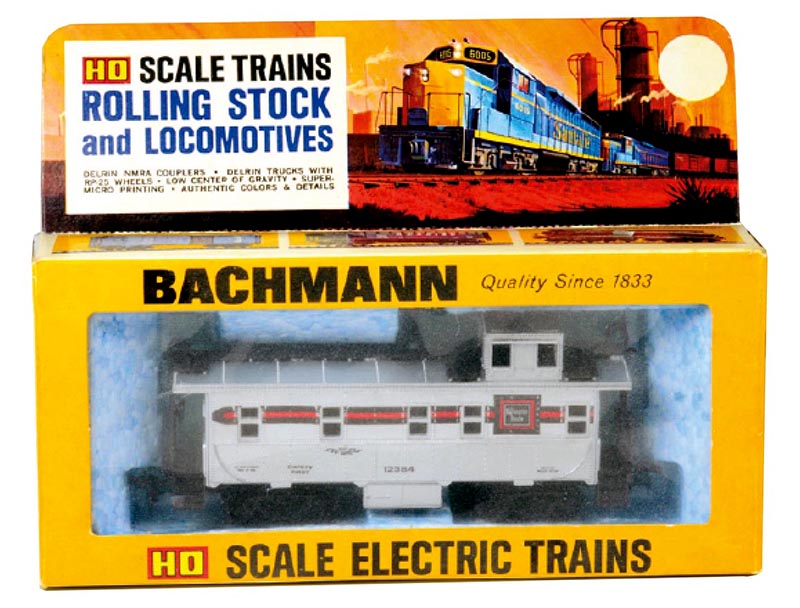 Early 1970s packaging for Bachmann’s line of HO-scale trains featured this yellow-and-white design. The silver Chicago, Burlington & Quincy example shown is one of the six road names to arrive with the debut of Bachmann’s HO locomotives and rolling stock in 1970.
Early 1970s packaging for Bachmann’s line of HO-scale trains featured this yellow-and-white design. The silver Chicago, Burlington & Quincy example shown is one of the six road names to arrive with the debut of Bachmann’s HO locomotives and rolling stock in 1970.
This was not the first appearance for this caboose tooling. In early 1964, this caboose model, plus a boxcar, tank car, gondola, and a flatcar with logs debuted under the Crown Products name. Mantua sold the Hong Kong-made Crown line and listed it as a division of Mantua Metal Products. These 1960s Crown cars included Mantua’s Woodbury Heights, N.J., address and came in blister-pack cardboard packaging. My research uncovered that these were the first HO-scale Kader products sold in the United States. Kader later purchased Bachmann and continues to produce a wide variety model trains in various scales.
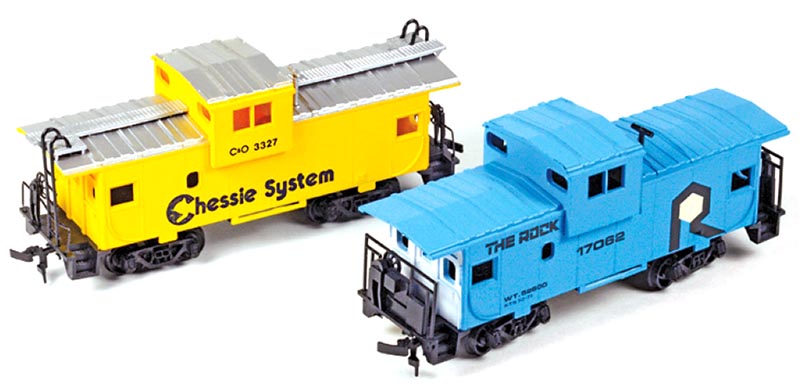 The wide-vision caboose model is the longest continuously available example in Bachmann’s HO line. The yellow Chessie System model is a mid-1970s version with rooftop running boards and high ladders. The blue Rock Island caboose sports modernized tooling that came out in the 1980s. The running boards disappeared with this tooling, and the model’s end railings are lower. These attributes reflect the style sold today by Bachmann in its Silver Series line with metal wheels and E-Z Mate knuckle couplers.
The wide-vision caboose model is the longest continuously available example in Bachmann’s HO line. The yellow Chessie System model is a mid-1970s version with rooftop running boards and high ladders. The blue Rock Island caboose sports modernized tooling that came out in the 1980s. The running boards disappeared with this tooling, and the model’s end railings are lower. These attributes reflect the style sold today by Bachmann in its Silver Series line with metal wheels and E-Z Mate knuckle couplers.
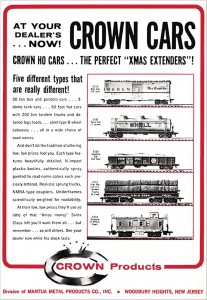 In addition to Bachmann’s products, Kader manufactured select items for Lionel’s HO line of the mid-1970s. Among the Kader-made items in Lionel’s 1976 and 1977 HO catalogs, you’ll find this off-center caboose available in Burlington Northern, Chessie System, Illinois Central Gulf, Norfolk & Western, Southern Pacific, Southern Railway, and Union Pacific. Some road names crossed between Bachmann’s and Lionel’s catalog, but some are exclusive to Lionel-HO of the time. You’ll discover differences between Bachmann and Lionel versions of these models. For example, Lionel’s Illinois Central Gulf caboose included a silver roof, Lionel’s name, a different typeface for the road’s name, plus a different road number than Bachmann’s model, which included an orange body roof and black cupola roof. As with other Kader products produced for Lionel, the spotting differences include Lionel’s name and a Taiwan origin mark on the underframe. A similar off -center cupola caboose is in Lionel’s 1974 catalog that introduced its HO line of the 1970s, but this and other early items were not made in Taiwan.
In addition to Bachmann’s products, Kader manufactured select items for Lionel’s HO line of the mid-1970s. Among the Kader-made items in Lionel’s 1976 and 1977 HO catalogs, you’ll find this off-center caboose available in Burlington Northern, Chessie System, Illinois Central Gulf, Norfolk & Western, Southern Pacific, Southern Railway, and Union Pacific. Some road names crossed between Bachmann’s and Lionel’s catalog, but some are exclusive to Lionel-HO of the time. You’ll discover differences between Bachmann and Lionel versions of these models. For example, Lionel’s Illinois Central Gulf caboose included a silver roof, Lionel’s name, a different typeface for the road’s name, plus a different road number than Bachmann’s model, which included an orange body roof and black cupola roof. As with other Kader products produced for Lionel, the spotting differences include Lionel’s name and a Taiwan origin mark on the underframe. A similar off -center cupola caboose is in Lionel’s 1974 catalog that introduced its HO line of the 1970s, but this and other early items were not made in Taiwan.
AHM’s 1970s line included some Taiwan-made items from Kader’s tooling, and this off-center cupola caboose may be among those releases. This caboose type is common in the hobby with the most famous example perhaps being the 1957-introduced Athearn model. AHM and Model Power imported a Roco-made example for many years. Though all appear similar, close inspection reveals variations between manufacturers and at times even differences in the same offering over the years from the one company. These variations add to the fun of collecting!
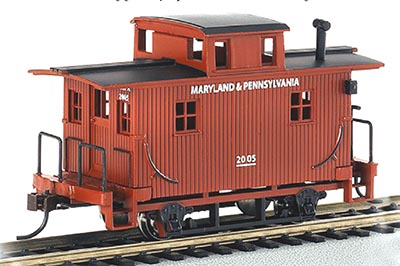 Bachmann added two new caboose models to its line in 1976. One is a wide-vision example. This model, reviewed in its recent Chessie System safety slogan dress in this edition of Model Railroad News, is now the longest running caboose in the company’s HO line. The other 1976 caboose arrival came with a collection of “Old West” freight cars and was a two-axle “bobber” prototype.
Bachmann added two new caboose models to its line in 1976. One is a wide-vision example. This model, reviewed in its recent Chessie System safety slogan dress in this edition of Model Railroad News, is now the longest running caboose in the company’s HO line. The other 1976 caboose arrival came with a collection of “Old West” freight cars and was a two-axle “bobber” prototype.
The wide-vision tooling generally replicates a 1960s International Car prototype and measures 36 feet. Originally, Bachmann’s wide-vision caboose came with high ladders to access the roof, plus walkway running boards. By the 1980s, Bachmann modernized its wide-vision and dropped the running boards and high ladders. New low railings arrived on the platform ends.
Bachmann’s 1976 line added a number of Old West items, including a 4-4-0 steam locomotive, four freight cars, the bobber caboose, plus a selection of building kits. The bobber appeared for years in the company’s line in red Central Pacific and yellow Union Pacific livery.
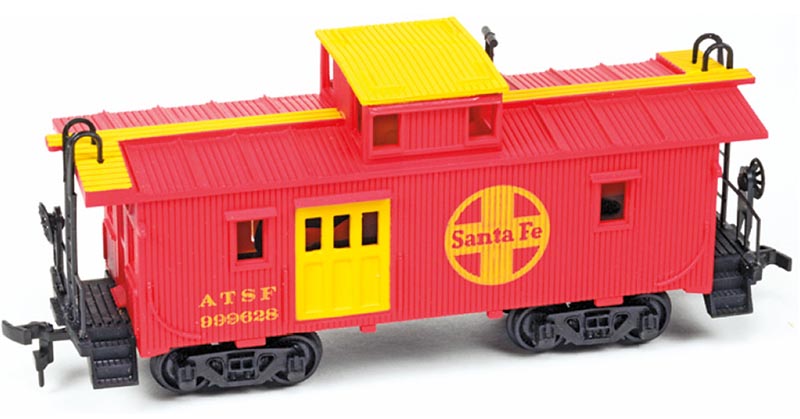 While I can’t confirm a prototype for this intriguing wood-side caboose with a wood roof, it is an interesting model. Sold in an action accessory release, the reverse side of this model includes an operating sliding door with a brakeman figure that pops out to collect a mail bag from the included raised platform.
While I can’t confirm a prototype for this intriguing wood-side caboose with a wood roof, it is an interesting model. Sold in an action accessory release, the reverse side of this model includes an operating sliding door with a brakeman figure that pops out to collect a mail bag from the included raised platform.
For 1978, a new action-accessory release presented a wood-side center-cupola caboose. Decorated for Santa Fe, this caboose is among the more uncommon to locate today. An opening side door triggered as the caboose passed a platform, and a brakeman emerged from the model to “grab” the mail bag as the train rolled past. By 1983, this act ion accessory was missing from Bachmann’s line, but returned in 1988 and remained until 1993.
 This caboose hails from Bachmann’s Dr. Suess themed “Whoville Special” train set of a few years ago and closely matches CB&Q’s NE12 prototype. It is a great candidate for the Burlington modeler to consider for a kitbash project. This caboose was frequently included in train sets and came out in the early 1980s. It is readily available at train swap meets and on eBay.
This caboose hails from Bachmann’s Dr. Suess themed “Whoville Special” train set of a few years ago and closely matches CB&Q’s NE12 prototype. It is a great candidate for the Burlington modeler to consider for a kitbash project. This caboose was frequently included in train sets and came out in the early 1980s. It is readily available at train swap meets and on eBay.
The next new caboose to arrive in Bachmann’s line was probably its most distinctive and most useful for the serious kitbashing modeler . In 1982, a streamline-cupola caboose was included in the illustration for a Chessie System train set. This caboose reproduced the look of a mid-1950s class NE12 steel caboose built in Lincoln, Nebraska, by the CB&Q. For a review of this prototype, check out Waycars of the Chicago, Burlington & Quincy by Holrook and Lorenz, published in 1978 by Prototype Modeler magazine. With minor revisions over the years, this CB&Q prototype caboose remains a common entry in Bachmann trains sets.
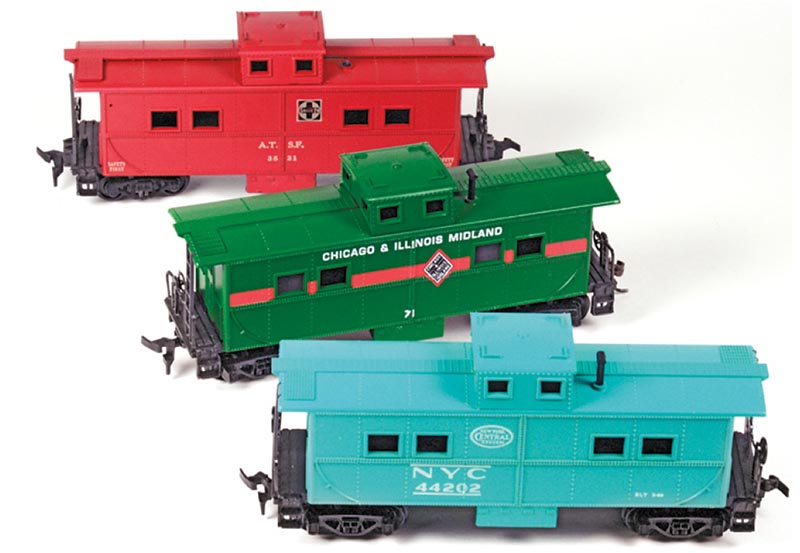 In the background is an early 1960s Lindberg Santa Fe example, in the middle is a 1980s Mantua Chicago & Illinois Midland, and in the foreground is a mid-1980s Bachmann New York Central version of this Northeastern-style caboose. While there are some variations — note the Lindberg’s running boards are separate — this appears to be the same tooling across three product lines and many decades of production. This caboose stayed with Bachmann for a short time in the mid-to-late 1980s.
In the background is an early 1960s Lindberg Santa Fe example, in the middle is a 1980s Mantua Chicago & Illinois Midland, and in the foreground is a mid-1980s Bachmann New York Central version of this Northeastern-style caboose. While there are some variations — note the Lindberg’s running boards are separate — this appears to be the same tooling across three product lines and many decades of production. This caboose stayed with Bachmann for a short time in the mid-to-late 1980s.
The curiosity in Bachmann’s HO-scale caboose collection was in the 1983 product catalog. Listed simply as “36-foot Caboose,” a set of four road names was present. The CB&Q and Seaboard Coast Line examples were Bachmann’s off-center cupola model from 1970. The other two entries featured a Northeastern-style center cupola and included Chicago & North Western and New York Central. The tooling closely matches the caboose found in Mantua’s line of the 1980s, which had its heritage in Lindberg’s early 1960s line. My New York Central example includes no country-of-origin marking s on the under frame and no manufacturer name. The final appearance of this curious caboose model was 1986.
As Bachmann upgraded its products in the late-1980s and early-1990s, the company introduced its popular Spectrum line, E-Z Track system, and E-Z Mate knuckle couplers, as well as the Silver Series rolling stock line. The modernized wide-vision caboose saw improvements in 1996 with the Silver Series debut. Originally, the friction truck sideframes included plastic wheels, and extended X2f couplers came mounted on the trucks. For its Silver Series enhancement, new truck sideframes of the leaf-spring caboose variety arrived with metal wheels. The couplers became body mounted and included Bachmann’s E-Z Mate knuckles. The bobber caboose expanded its road name collection around 2000 and gained metal wheels and knuckle couplers.
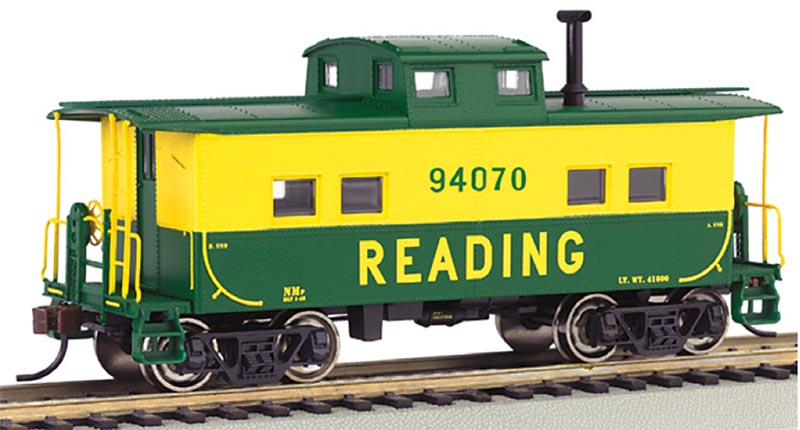 The best of the bunch, Bachmann’s Northeastern-style steel caboose came out in 2012. A number of road names are available for this model in HO scale, which rides on leaf-spring truck sideframes with metal wheels. The model includes clear window material and knuckle couplers.
The best of the bunch, Bachmann’s Northeastern-style steel caboose came out in 2012. A number of road names are available for this model in HO scale, which rides on leaf-spring truck sideframes with metal wheels. The model includes clear window material and knuckle couplers.
The most recent and most impressive addition to Bachmann’s HO caboose line is 2012’s northeast example. This new tooling addition presented a center-cupola, rivet-side steel caboose model. Road names and new road numbers continued to arrive from Bachmann for this well-done caboose effort.
To be a completist, it should be noted that neither “Thomas,” nor “Chuggington” HO lines included a caboose. Bachmann’s 2013 catalog teased with images of the off-center cupola caboose from 1970 in Santa Fe, Southern Railway, and holiday-themed dress in illustrations for a pair of train sets. To my knowledge, production examples provided the CB&Q-style streamlined cupola caboose.
I welcome reader feedback and any additional information regarding these caboose models and other hobby history subjects. My goals in sharing this material, both in Model Railroad News and online at my HO-Scale Trains Resource, is to expand the general knowledge base, document and preserve our hobby’s history, and, of course, to enjoy and have fun with model trains!


